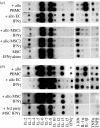Immune response to stem cells and strategies to induce tolerance
- PMID: 17584730
- PMCID: PMC2440400
- DOI: 10.1098/rstb.2007.2120
Immune response to stem cells and strategies to induce tolerance
Abstract
Although recent progress in cardiovascular tissue engineering has generated great expectations for the exploitation of stem cells to restore cardiac form and function, the prospects of a common mass-produced cell resource for clinically viable engineered tissues and organs remain problematic. The refinement of stem cell culture protocols to increase induction of the cardiomyocyte phenotype and the assembly of transplantable vascularized tissue are areas of intense current research, but the problem of immune rejection of heterologous cell type poses perhaps the most significant hurdle to overcome. This article focuses on the potential advantages and problems encountered with various stem cell sources for reconstruction of the damaged or failing myocardium or heart valves and also discusses the need for integrating advances in developmental and stem cell biology, immunology and tissue engineering to achieve the full potential of cardiac tissue engineering. The ultimate goal is to produce 'off-the-shelf' cells and tissues capable of inducing specific immune tolerance.
Figures



Similar articles
-
Tolerance strategies for stem-cell-based therapies.Nature. 2008 May 15;453(7193):330-7. doi: 10.1038/nature07041. Nature. 2008. PMID: 18480814 Review.
-
In vivo tissue engineering of heart valves: evolution of a novel concept.Regen Med. 2009 Jul;4(4):613-9. doi: 10.2217/rme.09.22. Regen Med. 2009. PMID: 19580409
-
Avoiding immunological rejection in regenerative medicine.Regen Med. 2015;10(3):287-304. doi: 10.2217/rme.15.11. Regen Med. 2015. PMID: 25933238 Review.
-
[Stem cells and cardiac regeneration].Medicina (B Aires). 2006;66(6):574-82. Medicina (B Aires). 2006. PMID: 17240634 Review. Spanish.
-
"Stealth immune tolerance" in stem cell transplantation: potential for "universal donors" in myocardial regenerative therapy.J Heart Lung Transplant. 2005 May;24(5):511-6. doi: 10.1016/j.healun.2004.11.010. J Heart Lung Transplant. 2005. PMID: 15896746 Review. No abstract available.
Cited by
-
The immunogenic profile and immunomodulatory function of mesenchymal stromal / stem cells in the presence of Ptychotis verticillata.Heliyon. 2024 Jan 20;10(3):e24822. doi: 10.1016/j.heliyon.2024.e24822. eCollection 2024 Feb 15. Heliyon. 2024. PMID: 38317994 Free PMC article.
-
A concerted HIF-1α/MT1-MMP signalling axis regulates the expression of the 3BP2 adaptor protein in hypoxic mesenchymal stromal cells.PLoS One. 2011;6(6):e21511. doi: 10.1371/journal.pone.0021511. Epub 2011 Jun 27. PLoS One. 2011. PMID: 21738685 Free PMC article.
-
Introduction. Bioengineering the heart.Philos Trans R Soc Lond B Biol Sci. 2007 Aug 29;362(1484):1253-5. doi: 10.1098/rstb.2007.2112. Philos Trans R Soc Lond B Biol Sci. 2007. PMID: 17569644 Free PMC article. No abstract available.
-
Mesenchymal stem cells: paracrine signaling and differentiation during cutaneous wound repair.Exp Cell Res. 2010 Aug 15;316(14):2213-9. doi: 10.1016/j.yexcr.2010.05.009. Epub 2010 May 13. Exp Cell Res. 2010. PMID: 20471978 Free PMC article. Review.
-
Recent Methods for Modifying Mechanical Properties of Tissue-Engineered Scaffolds for Clinical Applications.Biomimetics (Basel). 2023 May 16;8(2):205. doi: 10.3390/biomimetics8020205. Biomimetics (Basel). 2023. PMID: 37218791 Free PMC article. Review.
References
-
- Aggarwal S, Pittenger M.F. Human mesenchymal stem cells modulate allogeneic immune cell responses. Blood. 2004;105:1815–1822. doi:10.1182/blood-2004-04-1559 - DOI - PubMed
-
- Alvarez-Dolado M, Pardal R, Garcia-Verdugo J.M, Fike J.R, Lee H.O, Pfeffer K, Lois C, Morrison S.J, Alvarez-Buylla A. Fusion of bone-marrow-derived cells with Purkinje neurons, cardiomyocytes and hepatocytes. Nature. 2003;425:968–973. doi:10.1038/nature02069 - DOI - PubMed
-
- Amit M, Shariki C, Margulets V, Itskovitz-Eldor J. Feeder layer- and serum-free culture of human embryonic stem cells. Biol. Reprod. 2004;70:837–845. doi:10.1095/biolreprod.103.021147 - DOI - PubMed
-
- Andreadis S.T. Gene transfer to epidermal stem cells: implications for tissue engineering. Expert Opin. Biol. Ther. 2004;4:783–800. doi:10.1517/14712598.4.6.783 - DOI - PubMed
-
- Anversa P, Leri A, Kajstura J. Cardiac regeneration. J. Am. College Cardiol. 2006;47:1769–1776. doi:10.1016/j.jacc.2006.02.003 - DOI - PubMed
Publication types
MeSH terms
LinkOut - more resources
Full Text Sources
Other Literature Sources
Medical

